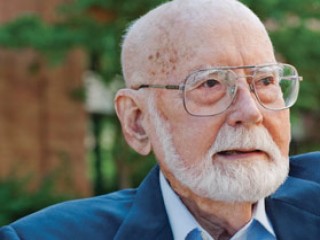
E. Donnall Thomas biography
Date of birth : 1920-03-15
Date of death : -
Birthplace : Mart, Texas, U.S.
Nationality : American
Category : Science and Technology
Last modified : 2011-09-21
Credited as : physician, Nobel Prize for Physiology or Medicine, leukemia
0 votes so far
Thomas studied at the University of Texas (B.A., 1941; M.A., 1943) and the Harvard Medical School (M.D., 1946). He served at a few hospitals and a research centre before becoming a professor of medicine at Columbia University's College of Physicians and Surgeons (1955-63) and the University of Washington School of Medicine (from 1963) in Seattle, where he was also associated with the Fred Hutchinson Cancer Research Center.
In 1956 Thomas performed the first successful bone marrow transplant between two humans: a leukemic patient and his identical twin. The recipient's body accepted the donated marrow and used it to make new, healthy blood cells and immune system cells. Thomas adopted methods to match the tissues of donor and recipient closely enough to minimize the latter's rejection of the former's marrow, and he also developed drugs to suppress the immune system. In 1969 these refinements enabled him to perform the first successful bone marrow transplant in a leukemia patient from a relative who was not an identical twin. Before his work, leukemia had invariably been a fatal disease. By 1990, partially as a result of his research, more than half of all leukemia patients could be expected to survive.
In 1990 Thomas was awarded the U.S. National Medal of Science. Thomas also wrote several books during his career, including Aplastic Anemia (1978), Frontiers on Bone Marrow Transplantation: Fetal Hematopoiesis (1991), and Hematopoietic Cell Transplantation (1999; cowritten with Stephen J. Forman and Karl G. Blume).
















